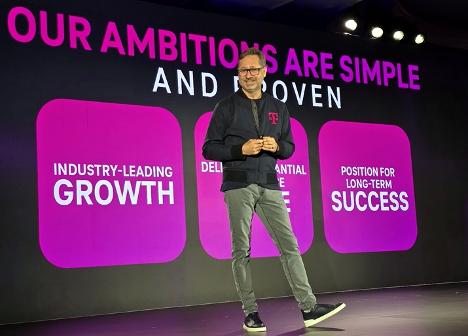At T-Mobile’s recent Capital Markets Day in San Francisco, the company laid out its successes in the past three years since the last Capital Markets Day it held for financial and industry analysts. This meant covering three years of T-Mobile’s growth both as a company and as a network and how it has used its merger with Sprint to accelerate growth and profitability. With that historical overview as backdrop, the event turned to its real purpose: looking into the future and explaining the company’s plans to continue—and even accelerate—its growth using technology. Given the current market climate, T-Mobile’s plans of course involve a healthy dose of AI, including partnerships with AI leaders such as OpenAI and Nvidia.
T-Mobile’s Past Successes
T-Mobile has built a lot of credibility with both industry and financial analysts thanks to its past successes. After all, it’s a lot easier to believe someone’s vision for the future if they have established a track record of successfully executing in the past. That’s exactly what T-Mobile did at its Capital Markets Day by talking about its more than 12 million post-paid net adds during the past three years, which it claims is more net adds than all of its competitors combined.
T-Mobile also explained how it exceeded its own projections for the Sprint merger. It predicted synergy savings of $6 billion for the combined company, then revised that upward to $7.5 billion and then ended up beating even that number by hitting $8 billion in savings and completing the network integration a year early besides. T-Mobile has also delivered mostly stellar financial results, which have driven the stock price higher, increasing the company’s market cap by nearly 50% over the past three years.
FWA And Fiber Future
One of the “killer apps” of 5G has been fixed wireless access, known as FWA. It began in the early days of 5G with mmWave to make it easier to get signal to people’s homes, but then evolved into a way for companies like T-Mobile to compete with cable providers. T-Mobile originally aspired to have somewhere in the ballpark of 7 to 8 million FWA customers in the United States by 2025; it currently has 5.6 million, having just added 400,000 last quarter. T-Mobile’s strategy now is to deliver FWA in areas where there is fallow spectrum and the network isn’t under heavy load from mobile customers. This is especially attractive in rural areas where T-Mobile owns spectrum licenses and may already have towers in place but is not serving many users. As T-Mobile pushes to add more rural customers with this FWA strategy, it plans to now target a customer base of 12 million by 2028. T-Mobile has also increased FWA speeds by 3x since it launched in Q1 of 2021, and it claims 3x higher user satisfaction compared to cable.
However, T-Mobile’s broadband plans are not limited to FWA anymore, as it has established partnerships and joint ventures with Metronet, Lumos and others. These fiber deals will put T-Mobile in the position to serve 12 to 15 million households by 2030 with its current fiber plans and its existing partners. As a long-time fiber customer of a competitor’s product, I can add that fiber is far superior to cable in nearly every way, and I believe that the industry is seeing that.
T-Mobile’s competitors are already heavily invested in fiber, including AT&T with its sizable customer base and Verizon, which recently announced plans to acquire Frontier Communications for $20 billion. (This reunites Verizon with some of the assets, including fiber, that it sold to Frontier for $10 billion in 2016.) Clearly, the future is fiber, and as one other indicator of this, even copper-based cable companies now regularly use fiber terminology to confuse customers.
Investing In The Future Network
At the event, T-Mobile explained how it plans to build on its prior successes. This starts with its existing network. T-Mobile believes that its spectrum and network assets are unmatched in the industry; this claim is supported by its nearly 400 megahertz of sub-6-gigahertz 5G spectrum, which is over 100 megahertz more than its nearest competitor. Yes, Verizon does also have mmWave spectrum, but that coverage is limited to roughly 1% of the United States. T-Mobile says that its macro network is built on a dense mid-band grid that combines low-band 600-megahertz with both FDD and TDD mid-band spectrum to achieve better coverage and speeds. In fact, T-Mobile showed a graph based on OpenSignal data that indicates T-Mobile’s 5G availability improving from 30% in the second half of 2020 to 68% in the first half of this year. Putting this in the context of other OpenSignal data, this figure represents 5x better availability than T-Mobile’s nearest competitor.
T-Mobile also claims that its 2.5-gigahertz mid-band network provides up to 30% more coverage than C-Band, the core of its competitors’ 5G networks. T-Mobile’s 5G Advanced network also delivers 4x CA (carrier aggregation) and uplink CA, improving speeds (30%) and extending coverage (15%) compared to the old network. In fact, according to Ookla data, as of Q2 of this year, T-Mobile’s 5G speeds are 2.5 times that of the competition, even after the C-Band rollout. Even with all these advancements, T-Mobile’s spectrum deployment is still ongoing, with only 60% of 5G spectrum deployed and its own C-Band deployment coming soon. T-Mobile also plans to increase spectral efficiency from radio software features and deploy new hardware with advanced massive-MIMO across all spectrum bands.
With the introduction of Standalone 5G and 5G Advanced, T-Mobile plans to continue to take advantage of new 5G capabilities. The company claims that it is the first and only scaled Standalone 5G network, complete with VoNR (voice over NR), even higher order carrier aggregation (5CA), network slicing and private networks.
5G Advanced, sometimes referred to as 5.5G, is a half-step towards 6G but also fulfills many of the promises of 5G because it requires Standalone 5G infrastructure for most features. (For a detailed treatment of the slow rollout of Standalone 5G by the U.S. carriers and the historical complications that created, check out this research paper that I wrote last year.) 5G Advanced will leverage AI-powered features to further improve radio efficiencies and speed up network performance. Other 5G Advanced functionalities such as L4S should improve quality of service, on top of the improvements that will come from network slicing and the inclusion of RedCap for IoT. (If you care about the specifics of the network standards, RedCap actually predates 5G Advanced in Rel. 17, but comes after T-Mobile’s rollout of Standalone 5G, so RedCap got wound into Rel. 18, which is also known as 5G Advanced.)
AI Partnerships With OpenAI And Nvidia
T-Mobile is also using AI to enhance the customer experience. It is using customer-driven coverage—generated by AI using real customer data—to help investigate issues and make decisions based on user feedback. One way it is using AI is through its partnerships with companies such as OpenAI and Nvidia. T-Mobile has partnered with Nvidia to build its AI-RAN (known as AI Aerial), which the carrier calls “the multi-purpose cloud network of the future.” This new network will allow T-Mobile to simultaneously run telco workloads alongside AI-RAN and device AI workloads—all on the same network—to take advantage of more of the AI compute available in the network. The Nvidia AI-RAN will be available through existing infrastructure vendors Ericsson and Nokia. Nvidia has built a new appliance for AI-RAN that it calls Aerial RAN Computer-1, or ARC-1, which will serve as the foundational modular design for the architecture. The ARC-1 takes advantage of Nvidia’s new Blackwell generation of GPUs paired with its Grace CPUs to create a complete device for AI-RAN.
In addition to Nvidia, T-Mobile has also leaned heavily into its partnership with OpenAI, which is meant to revolutionize the carrier’s customer service. The partners have created a new platform they are calling IntentCX that is supposed to understand complex, multi-layered requests in multiple languages. It is designed to perform tasks autonomously with user permissions and take advantage of the billions of data points that T-Mobile has captured from real customer interactions. IntentCX is also intended to deliver personalized service based on existing data and offer real-time decision-making and faster responses. It should help T-Mobile centralize the customer experience and be much more aware of customer needs, and down the road it could even anticipate customer needs. T-Mobile expects the platform to be integrated into its operations in 2025.
T-Mobile Pursues Government Contracts With T-Priority
Last but not least, T-Mobile for Business announced a new service called T-Priority, which it claims is the world’s first network slice specifically for first responders. T-Mobile has created this as a service for emergency personnel who need more capacity or even potentially a backup to current first-responder solutions such as FirstNet. In fact, T-Mobile claims that T-Priority is 2.5x faster than AT&T and Verizon’s competitive offerings. T-Mobile also says that T-Priority has 5x the network resources that the average commercial user has today, which I believe means that T-Mobile is confident in its ability to serve first responders even in congested times.
T-Priority gets the highest level of prioritization across every 5G band, maintaining minimum service levels even during extreme congestion. While it remains unclear how many first responders will make the switch to T-Mobile, I do think it would be beneficial to have T-Priority as a backup at the very least. I imagine that in very large emergencies such as natural disasters, even first responder networks get congested, and having extra capacity like T-Priority would be very helpful.
The Future Of T-Mobile Is AI
T-Mobile’s partnerships with OpenAI for customer service and Nvidia for AI-RAN make it clear that T-Mobile is leaning heavily on AI to accelerate its future growth. The company is embracing AI in ways that I haven’t seen from any other carrier, even though we’re already seeing some carriers such as Verizon talk about building their own GPU clouds. T-Mobile is embracing AI in virtually every part of its business: its world-class 5G network, customer service, operations and new capabilities enabled by cloud AI. I do think that some of the AI advancements that T-Mobile is using to continue its growth will take time to implement, but I also believe that the ROI for things like IntentCX and AI-RAN will likely be very quick.
Read the full article here






